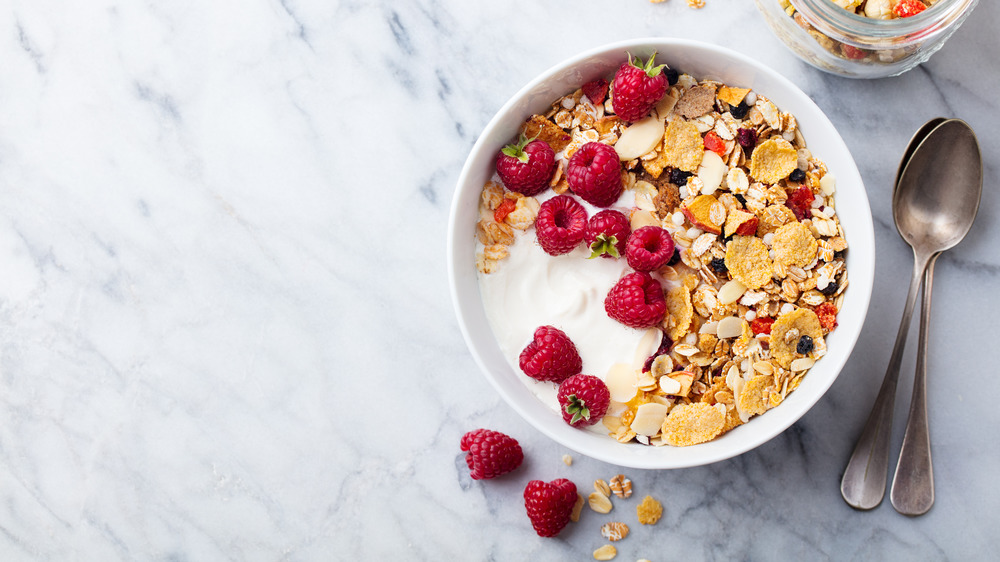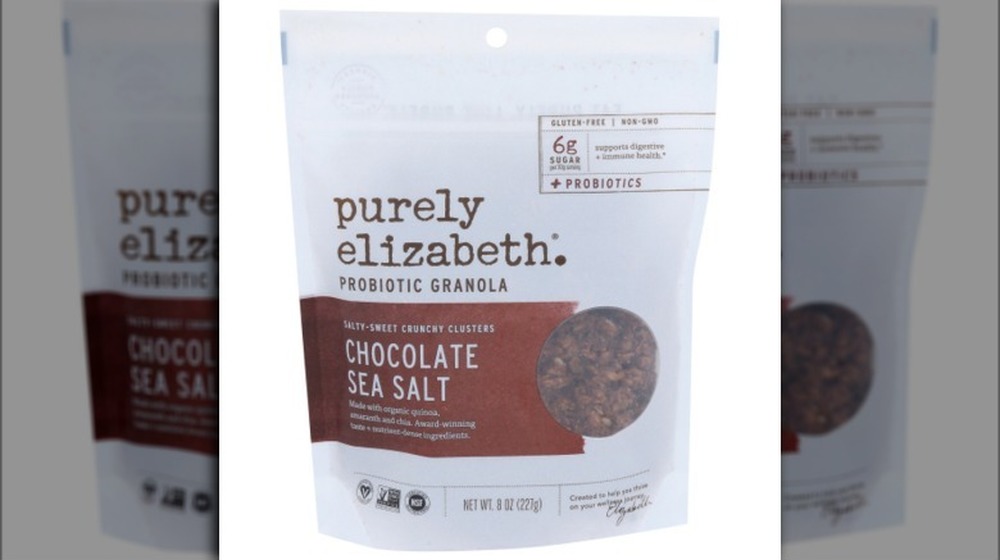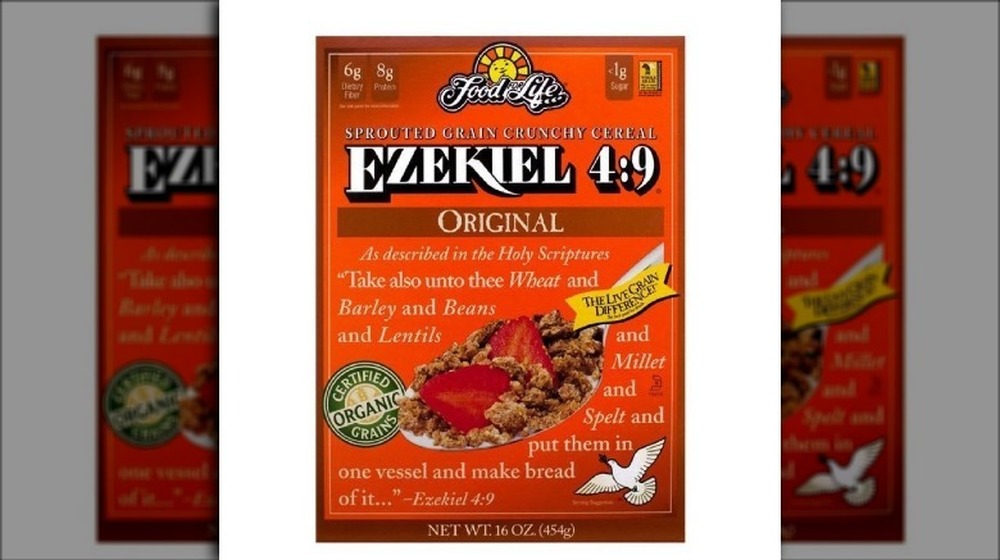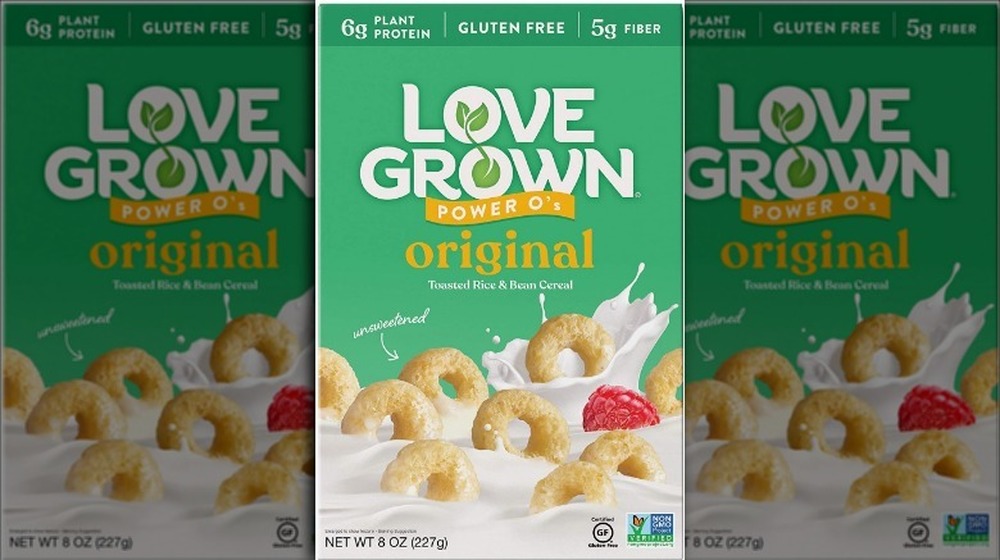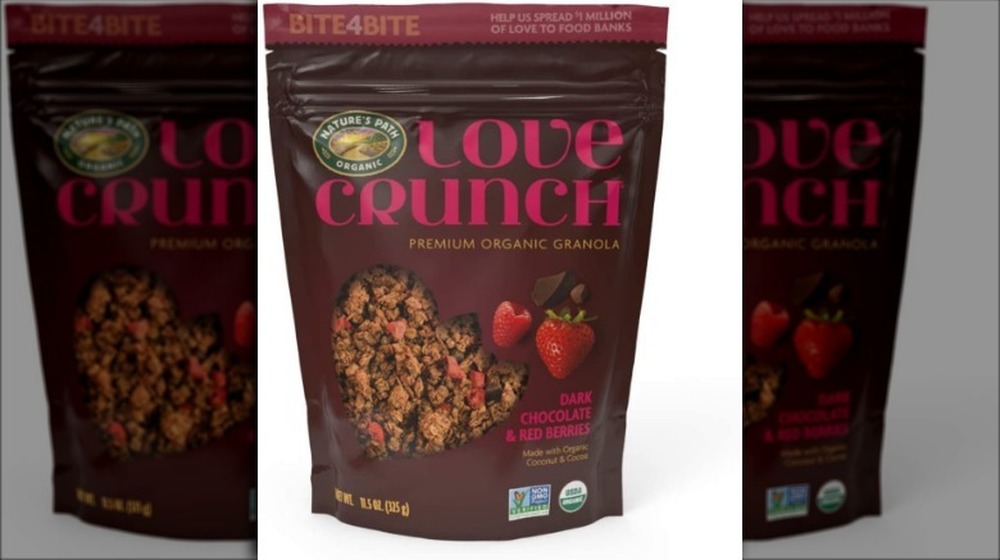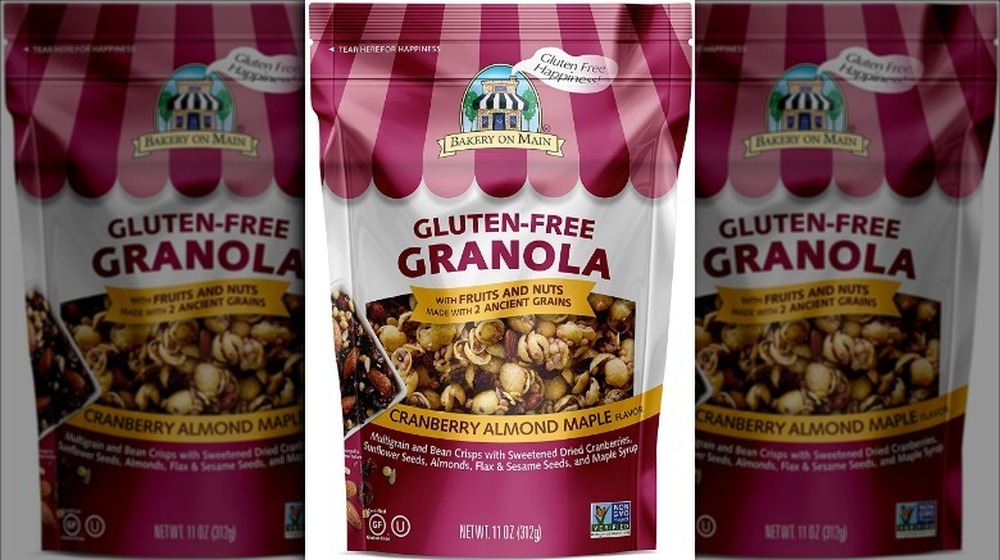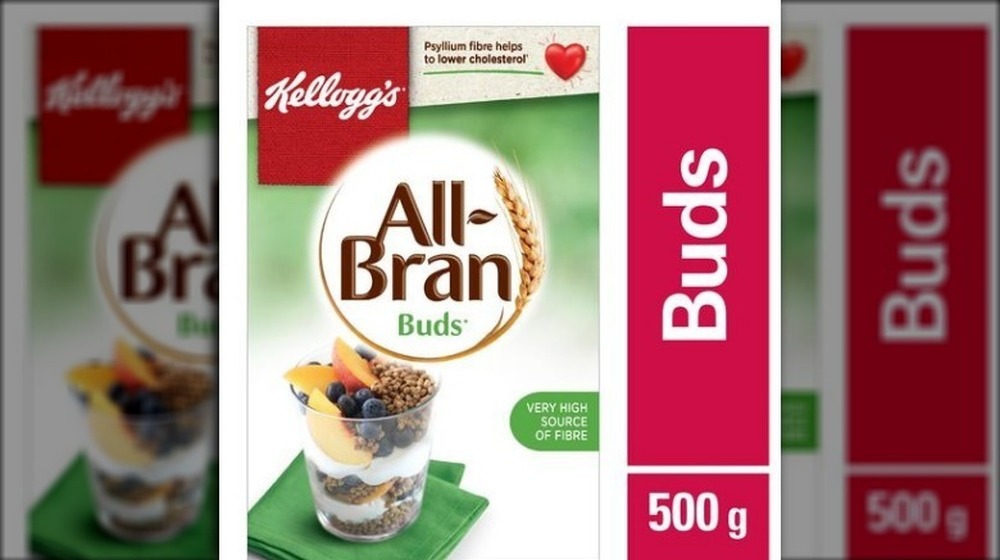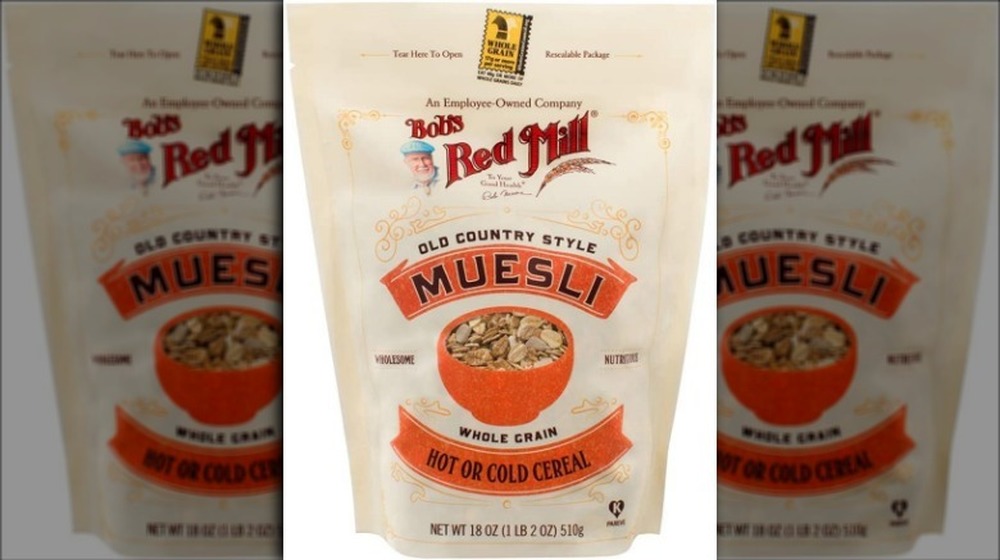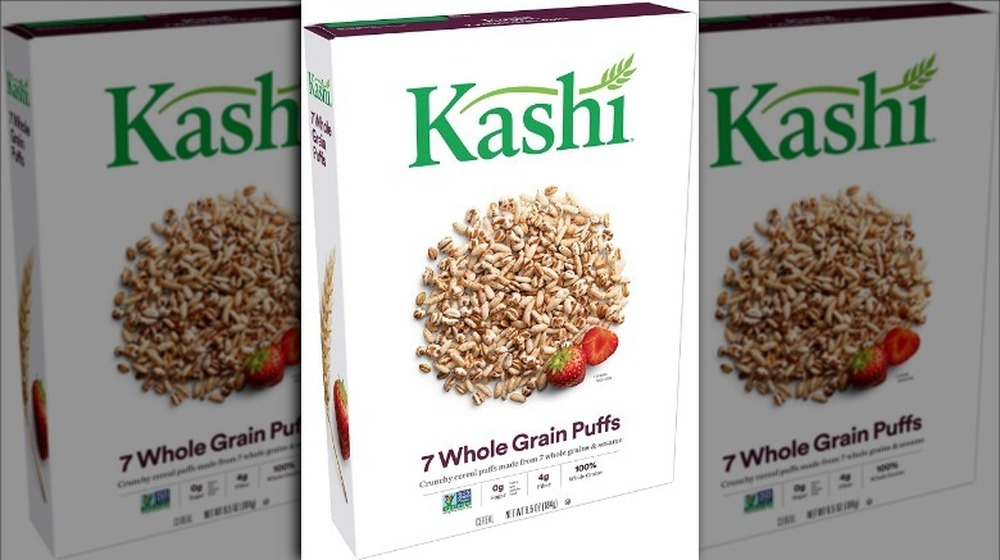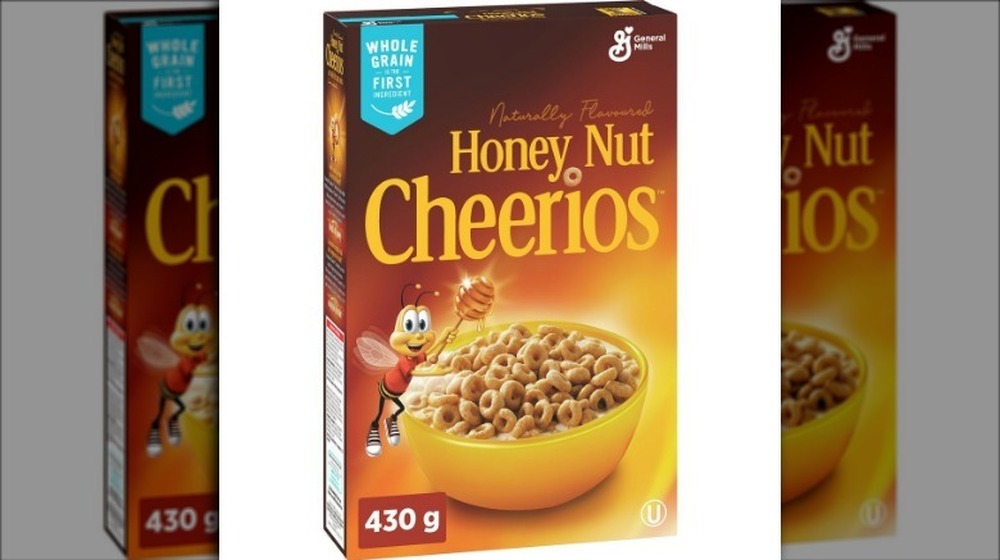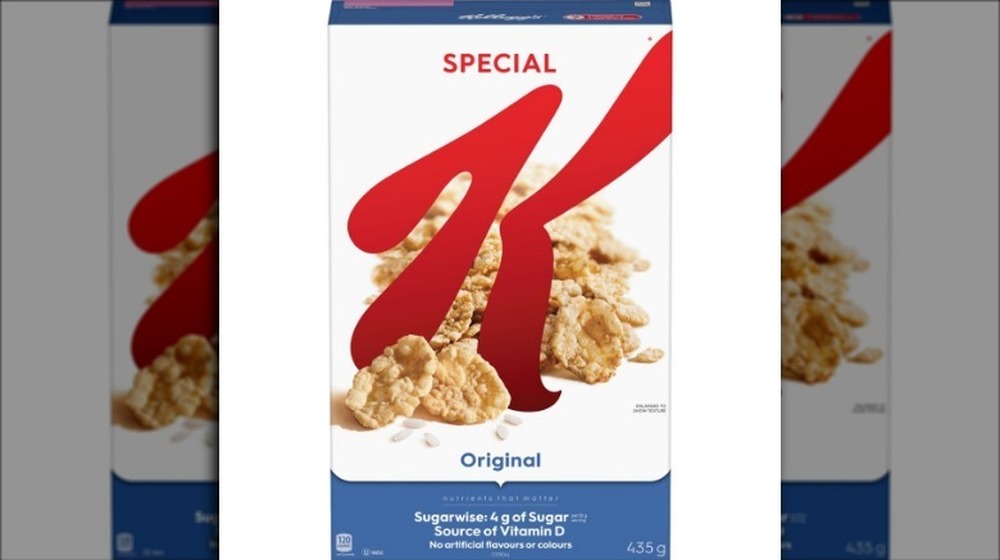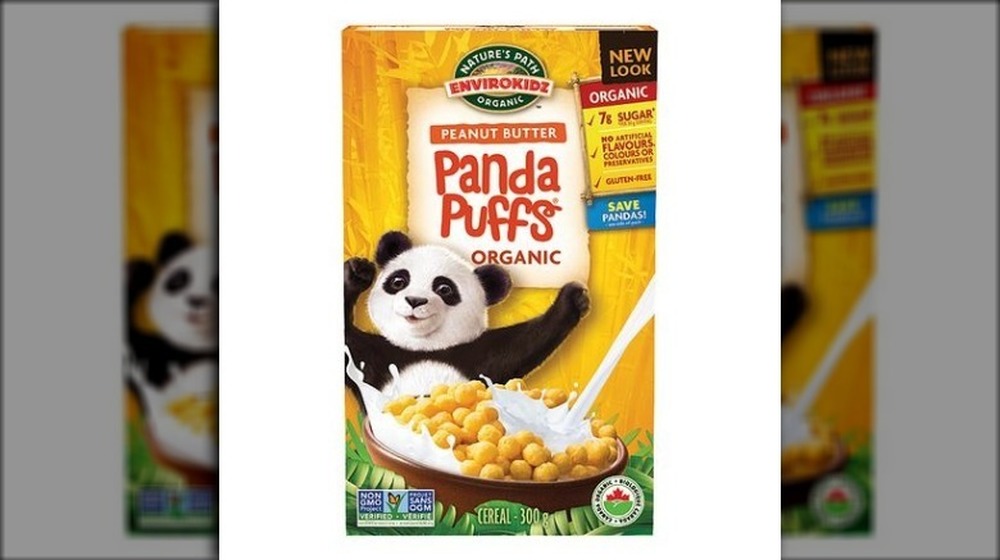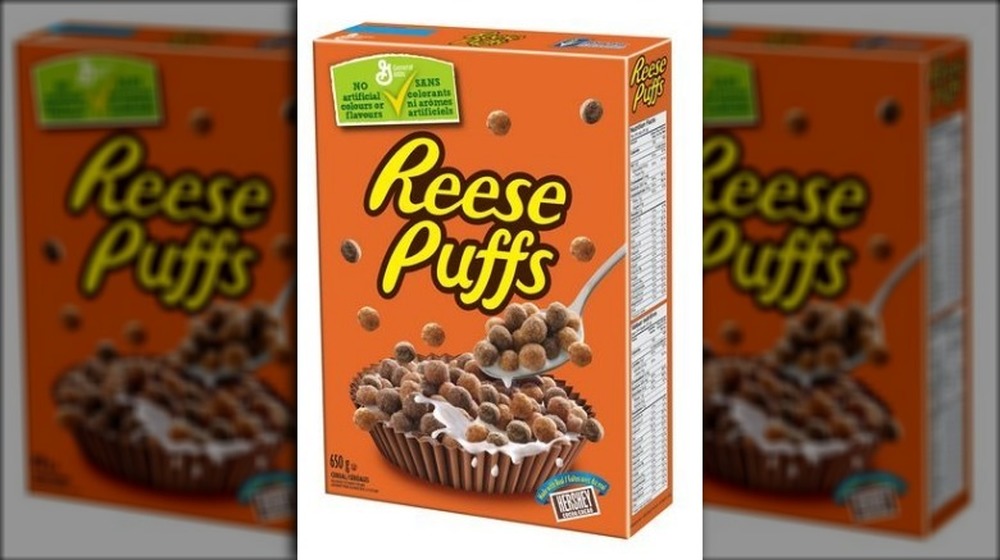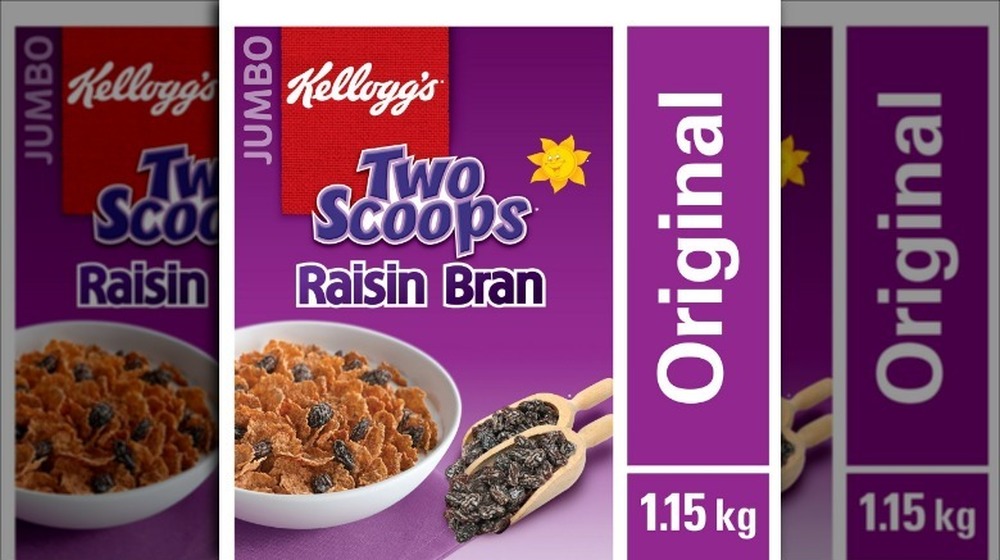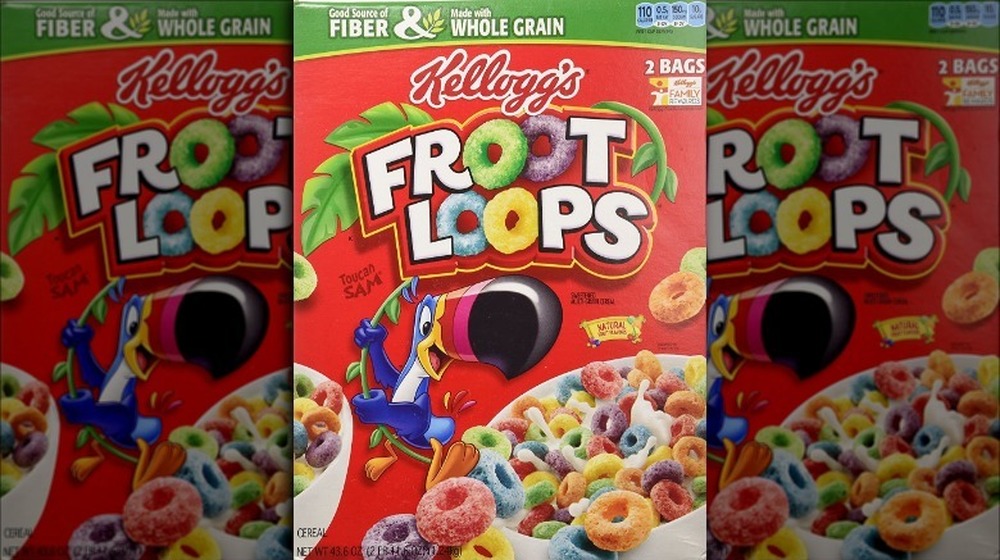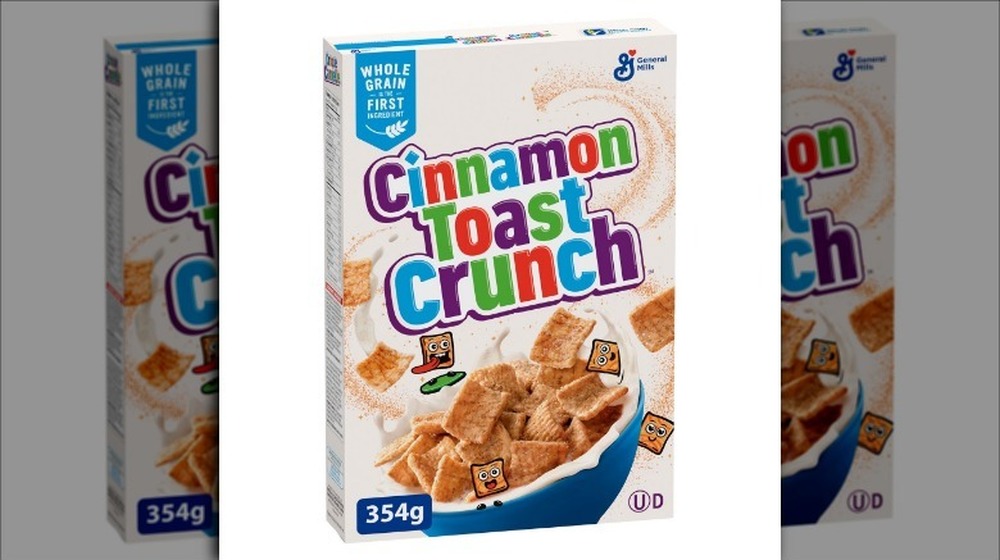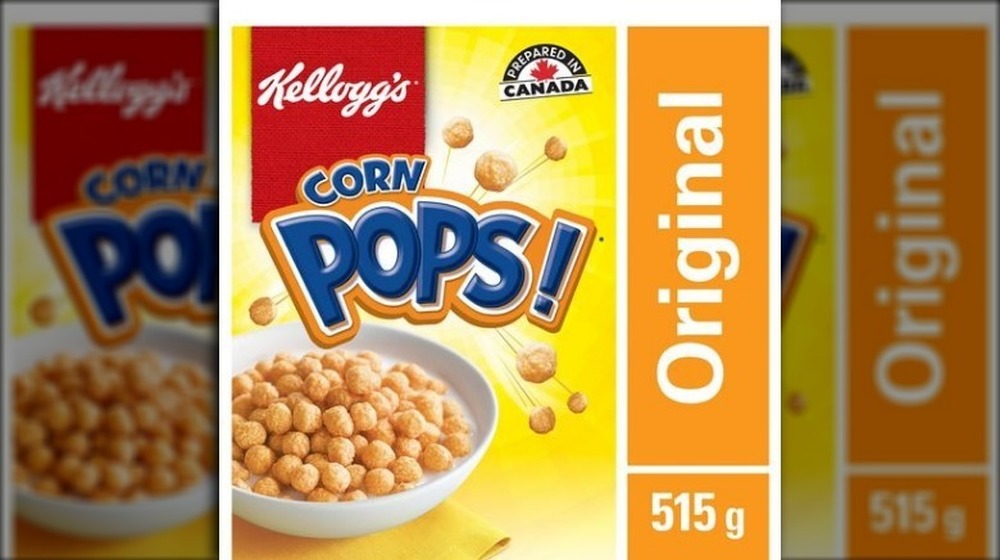8 Cereals You Should Be Eating And 8 You Shouldn't
We've all heard it said that breakfast is the most important meal of the day, yet only 34 percent of the population actually eats breakfast every day, according to a survey of 14,000 Americans (via FoodNavigator-USA). In fact, the average person in the US eats breakfast just three times a week!
That doesn't mean breakfast cereals aren't popular, though. And plenty of people eat breakfast cereals for other meals of the day; in fact, 79 percent of Americans sometimes eat cereal as a snack or a meal long after breakfast (via YouGov).But which cereals should you be eating? You probably know that those artificially-colored loops generally aren't what you should be downing all the time, but you might be wondering whether you should reach for a cup of muesli or some crunchy granola, or perhaps even a bowl of an organic copy-cat of a traditional favorite.
To make your choice a little easier, here are some of the granolas, O's, and non-GMO puffs (which might sound less appealing than Froot Loops but really are not!) that you should and shouldn't be having to start — or finish — your day.
Should: Purely Elizabeth Granola
Compared to other granolas, Purely Elizabeth's whole line of products is incredibly low in sugar. Spoon University even ranked the brand's Chocolate Sea Salt Probiotic Granola highest in its list of healthiest granola brands — and it edged out Back to Nature's Almond Chia Granola Clusters and KIND's Maple Quinoa Clusters with Chia Seeds. That's quite a win for a chocolate-flavored cereal!
The Chocolate Sea Salt flavor tops out at just 6 grams of sugar per 1/3 cup serving and is made with a combination of coconut sugar and cane sugar, so it won't spike your blood sugar as much as straight cane sugar. By comparison, Purely Elizabeth's Honey Almond flavor has just 4 grams of sugar and the Original flavor has 7 grams.
What else makes this granola healthy? Purely Elizabeth granolas use gluten-free oats and non-genetically-modified-organism, or non-GMO, ingredients. They're also vegan, organic, and contain no artificial flavors. Plus, there's a grain-free line made with keto-friendly seeds and nuts. There's even a sweet and spicy cinnamon peanut butter flavor with MCT oil, which is a fatty acid found in coconut oil that might promote higher energy and weight loss.
How does the granola actually taste, though? According to Amanda Campbell of What's the Soup, it tastes healthy, but with enough flavor and crunch to feel like a treat rather than a punishment. Meanwhile, Good Housekeeping sings the praises of the pumpkin cinnamon flavor, calling it one of the "30 Best Healthy Whole-Grain Cereals."
Should: Ezekiel 4:9 Sprouted Whole Grain Cereal
This is the OG crunchy, healthy cereal from a brand that was around long before sprouted grains became a brunch menu staple along with avocado toast, according to HuffPost. Ezekiel 4:9 can't really be called a granola considering there's no sugar in the original flavor, but once try it, you'll appreciate the granola-like texture even without the sweetness.
You'll also appreciate that the ingredient list is short, organic, and contains sprouted grains and high-fiber legumes. There's also a bit of salt, so it doesn't taste completely bland. And what's the deal with sprouting? Sprouting is supposed to make Ezekiel cereal easier to digest and more nutritious.
We highly recommend adding fruit or dried fruit to give this cereal a bit more flavor. If you want a little sweetness in the product itself, the cinnamon raisin Ezekiel 4:9 cereal has 8 g of sugar per serving, but only from raisins — not from honey, syrups or refined sugar. The cinnamon probably also helps fool you into thinking there's more sugar in your bowl, like you're eating a crunchy, healthy cinnamon French toast. The other flavors of the crunchy cereals have just 1 g of sugar per serving, while the flake cereals (e.g. almond flake, Flax + Chia) have a bit more from organic agave (which is also lower on the glycemic index than cane sugar).
So, even though it's not the slickest brand on the block, you can feel really good about eating Ezekial cereal.
Should: Love Grown Power O's Original Cereal
This bean-based, corn-free and oat-free alternative to Cheerios has more protein, even less sugar (0 grams!) and more fiber than its popular competition. Secondly, It's also an option for gluten-free dieters. And third –– and this might be the best part — the ingredients list is super short with protein-rich legumes: navy beans, lentils, garbanzo beans, brown rice, salt and Vitamin E to maintain freshness. And no, it doesn't taste like beans.
There are no added vitamins and minerals other than the E — unlike with Cheerios — so this cereal is probably best eaten by people who are already eating a healthy diet and don't need their vitamins in cereal form.
The only downside of Love Grown Power O's is the texture. It's a bit tougher than Cheerios, so it can be a little rough on sensitive gums if you don't let the cereal soak in your milk of choice for a bit first. Reviews on Amazon indicate the crunch is addictive, though. As for flavor, there are the more tasty chocolate and cinnamon flavors, though those have a fair bit of added cane sugar (9 grams in a one-cup serving).
Should: Love Crunch Dark Chocolate & Red Berries Granola
What a great name, right? And that heart-shaped strawberry and partially transparent packaging lets you peak the chocolate chunks and dried red berries on the inside. Brilliant.
This Love Crunch cereal is also organic, whole-grain and non-GMO to boot, which partially makes up for the 12 g of sugar per serving it contains, which might be unhealthy for some. Food reviewer Amanda Campbell of What's the Soup says that while it is less expensive and packs a bigger flavor punch, Love Crunch Dark Chocolate & Red Berries granola is probably not as good for you as Purely Elizabeth granola. And keep in mind that a serving is half a cup, and who eats just a half a cup of granola? That's fine if this is dessert or a snack, but for breakfast, this cereal might not make the cut if you're watching your calories, considering that half-cup nets 250 calories before you even add milk or toppings.
Still, Love Crunch is definitely one that tries to lean toward healthy –- as healthy as chocolate cereal gets, anyway. Just remember that a lot of the flavors are more on the treat side: the dark chocolate and peanut butter version is sort of an adult version of a Reese's Puffs (see below), and the espresso vanilla cream version is essentially an affogato with white chocolate, which is a far cry from a balanced breakfast despite the jolt of 11.55 milligrams of caffeine.
Should: Bakery on Main Cranberry Almond Maple Granola
These oat-free, gluten-free clusters are at the top of their class for crunchy bites. They're also definitely not as bone-dry and monastically healthy as some of the other options on this list (we're looking at you, Ezekiel, Bob's Red Mill, All-Bran Buds and Kashi's unsweetened 7 Whole Grain Puffs unsweetened).
It gets a respectable B on Fooducate, despite having less fiber than other healthy cereal options. So for a granola, it's really not bad. You get tons of crunch from the blend of nuts, corn, brown rice, beans, millet, teff and seeds, and the sweeteners are cane sugar combined with maple and caramelized pear juice. In fact, there's only 7 g of sugar in a 1/3 cup serving of the Cranberry Almond Maple flavor, which tastes plenty sweet and juicy. You could add fruit, but there's enough sweetness that you'd be better off adding a less sweet option (like one of those saintly options above) if you want to fill up your bowl with toppings, because good luck stopping at 1/3 of a cup. Still, if you're going to indulge on granola, this is one brand you're going to want to do it with.
P.S. It also makes a perfect topping for a quick dessert yogurt parfait, in case you prefer to save your sweetened crunchy foods for snacks and desserts.
Should: Kellogg's All-Bran Buds
Frankly, Kellogg's All-Bran Buds are not delicious. But they probably weren't meant to be. Instead, they do a heck of a job of keeping you "regular," thanks to wheat bran being the first ingredient, according to Kellogg's.
There are 11 grams of fiber in one serving of All-Bran Buds, which is just under half of your daily needs if you're a woman. Keep in mind that a serving is 1/3 cup, so if you eat an entire cup, you will most likely meet your fiber needs for the day. However, eating a whole cup also means you'd be eating the daily recommended sugar limit for women, which is 24 grams. This pushes All-Bran Buds way above more childlike options like Froot Loops and Reese's Puffs when it comes to sugar content.
Another downside of these Buds is that there's not much protein per serving — 3 grams, to be exact — to keep you feeling full. So our suggestion is to combine a serving of this with a low-sugar cereal (like the Ezekiel 4:9 original flavor) or lots of berries, nuts and seeds for texture, flavor and, well, joy. Because you're most likely not eating All-Bran Buds for fun.
Should: Bob's Red Mill Old Country Style Muesli
This breakfast cereal gets an impressive A- and a "Top Product" rating on Fooducate for its 100 percent whole-grain ingredients, its fiber content, and for being keto-friendly — all of which place it in the 10 percent of foods in its category.
You can eat Bob's Red Mill Old Country Style Muesli hot or cold, but is often soaked with milk, yogurt or grated fruit overnight. If not overnight, it's best to soak raw oat cereals like these for at least a few hours in advance, though, because eating them raw can be tough on your digestive system. Soaking oats provides a slow release of energy all morning long, while too much fiber without moister can give you that feeling of being a bit tied up in the gut.
Keep in mind that a serving of this cereal is just a ¼ cup, so if you start heaping it into a bowl, your sugar count could add up to be higher than you might prefer. The good news is that the sugar is from dates and raisins, though, rather than refined sugars. So, combined with the slowness of digestion and the whole grains, that's not a huge issue for your glycemic response, placing this cereal firmly in the "healthy" category.
Should: Kashi 7 Whole Grain Puffs
This Kashi 7 Whole Grain Puffs cereal gets a decent score on the Environmental Working Group's website. It's not organic-certified, but it has a decent amount of protein (5 grams) and fiber (4 grams). It's also made with non-GMO hard red wheat, brown rice, oats, barley, triticale, rye, buckwheat and sesame seeds and is completely unsweetened, unlike a lot of other Kashi products, including the company's GOLEAN Honey Almond Flax Crunch cereal with 12 g of sugar per a 3/4 cup serving.
What that might mean is that the 7 Whole Grain Puffs cereal is kind of bland on its own. It does seem good for you, however, so you can eat a whole 1 ½ cup serving, which is much larger than most other commercial cereals, since there isn't the worry you could go overboard on sugar.
You're probably going to want to add some fruit, yogurt or mix in a bit of another cereal if you want some sugar content and a bit more flavor, though. Just remember that while the cereal is crunchy on its own, it could soften up and turns mushy in milk. So, eat quickly unless you like your cereal soft! And if you want a sweet treat, the 7 Whole Grain Puffs cereal is also great for baking into whole-grain rice krispie treats, like with this copycat recipe from a Spark user.
Shouldn't: Honey Nut Cheerios
Unlike plain Cheerios, Honey Nut Cheerios contain a notable amount of sugar. They're enhanced with honey and brown sugar syrup for a grand total of 12 grams of added sweet stuff. In fact, one cup of the cereal has more sugar than three of Chips Ahoy! cookies (via The Naked Label).
It turns out that the honey nut version of Cheerios has 10 more grams of sugar than plain Cheerios That makes these a treat version of the original, which you might find bland without adding sweeteners. As The New York Times reports, Honey Nut Cherrios is also the kind of cereal some parents might buy for their kids while they buy the plain version for themselves, figuring that at least there are added vitamins and minerals in the sugary honey version — kind of like injecting a multivitamin into a cereal rather than asking your kids to take a pill.
Despite being the most popular breakfast cereal in the US, an Environmental Working Group analysis from nutritionist Dawn Underraga and investigations editor Bill Walker found that a "real world" serving of the cereal actually contains 20 grams of sugar. That same report also stated that eating excess sugar can increase your likelihood of obesity, Type 2 diabetes, cancer and heart disease and that "breakfast cereals are the fifth-highest source of added sugar in the diets of children under 8," falling behind only ice cream, candy, cookies and sugary drinks.
Shouldn't: Kellogg's Special K
While Kellogg's Special K is marketed as a healthy breakfast cereal, its refined grains and lack of fiber make it a not so great choice. A standard 12-ounce serving contains less than 1 gram of dietary fiber. The total added sugar is 4 grams and the amount of protein is 7 grams, which doesn't sound bad, but according to The Naked Label, the health claim of this cereal is mostly marketing; without fiber, those refined carbs could spike you blood sugar levels, which can lead to obesity. Even though 4 grams of sugar might not seem like a lot, there are 29 total grams of carbohydrates in Special K, and most people probably eat more than the suggested serving of 1 ¼ cups anyway.
Yes, Special K is low in fat, which might be where all that health-related marketing comes from, considering Special K was released in the 1950s, but all those excess sugars in the form of empty calories can turn into fat, so you're probably not doing yourself any favors by starting your day with it. If you're looking for an actually healthy cereal, it's better to choose one with lots of whole grains and a low added sugar content. But if Special K is your favorite cereal, maybe try adding it in moderation to lower-sugar options — or at least know that it's a treat, and maybe not a healthy start to the day.
Shouldn't: Nature's Path EnviroKidz Panda Puffs
It's easy to see why organic products appeal to parents who want to give their kids the cereals they're begging for but want to make sure they're not negatively affecting their health. To that end, the claim on the Nature's Path website is that their cereals are made with "only natural ingredients that parents can feel good about." But despite being organic and non-GMO, their Panda Puffs cereal marketing seems to be based on what isn't in the box rather than what is: whole grain corn meal, corn meal, cane sugar, peanut butter, soy oil, sea salt and tocopherols (for freshness). It seems like this cereal is made with just sweetened corn and soy oil. Nutritiously dense? Maybe not.
The rest of the EnviroKidz line also seems to offer lower-sugar and lower-preservative variations on some of the popular breakfast cereals below, but it's also equally questionable: The Leapin' Lemurs have chocolate, chocolate flavor and molasses, with 8 grams of sugar for a 3/4 cup serving, and the Koala Crisp swaps brown rice flour for the corn (and adds a few more grams of sugar to the chocolate flavor).
A better choice would be Nature's Path's Mesa Sunrise, which adds flax seeds, buckwheat flour, quinoa and amaranth to the corn base, with just 4 grams of sugar per 3/4 cup serving, though the low protein and fiber counts leave something to be desired.
Shouldn't: Reese Puffs
It's probably no surprise that Reese Puffs are not the epitome of health (via Eat This, Not That!). Basically, you should probably only grab a box of Reese Puffs off the shelf of the grocery store when you're planning to eat them as a high-sugar snack or dessert. They are not what a nutritionist would call a healthy breakfast.
Sure, we've all had morning when all we're craving is a bowl full of chocolatey, peanut buttery sugar that crunches, but you can't pretend that's good for you –- whatever your body is telling you (and whatever you drank the night before).
But boy are these Reese Puffs tasty, and the General Mills website tries to paint their nutrition as a pretty picture by mentioning that they contain added vitamins, 11 grams of whole grains, and no artificial colors or preservatives or high-fructose corn syrup, but there's still corn syrup and Hershey's chocolate in the mi, and the web experience leaves you feeling as though the nutritional label is masquerading as healthy, making the product seem even less so.
Shouldn't: Raisin Bran
What? Raisin Bran's not healthy?, you say. Yes, this cereal does have a healthy reputation, but Raisin Bran actually has more sugar per serving than Froot Loops with a whopping 17 grams. There is slightly less added sugar (9 grams instead of 12) than the popular kids cereal, but that's for a smaller serving of Raisin Bran.
Yes, some of that sugar comes from raisins, but there's also regular white sugar, brown sugar syrup and malt flavor in the cereal itself, most likely to mask that not-so-naturally-delicious bran.
With 5 grams of protein and 0 grams of saturated fat, Raisin Bran isn't all bad, but all in all, they're not a particularly healthy breakfast option. They also contain genetically engineered crops, aka GMOs, which author Michael Pollan of The Omnivore's Dilemma and In Defense of Food says can be (though aren't always) extremely bad for the environment (via Grub Street). Even if GMOs are not toxic to humans, the chemicals used to grow them can be, and they can also decimate butterfly populations (via Ag Mag).
The best way to eat Raisin Bran, if you truly love it, might be to combine a small portion with a low-sugar breakfast cereal higher on this list, like Bob's Red Meal Muesli, All-Bran Buds or the sugar-free original flavor of Ezekiel 4:9, all of which could handle a little sweetening up. Or just add some unsweetened raisins to any of the alternatives, and that should do the trick.
Shouldn't: Froot Loops
If you think those colors are all natural, think again. In addition to the fact that these multi-colored rings all actually taste the same (via Eat This, Not That!), they're packed with Red 40, Yellow 5, blue 1 and yellow 6 –- which are not there to be healthy or even delicious. The name is actually Froot Loops because there's no actual fruit in them — and they've been sued several times because of this.
Other ingredients in Froot Loops include BT, a controversial preservative that's been added "for freshness" and the hydrogenated oils (also known as trans fats), and 12 g of added sugar per serving, making them a less than great way to start your day. Furthermore, according to Spoon University, Froot Loops are 44 percent sugar by weight — it seems like they should be grouped with the candy bars in your local grocery or convenience store.
Why are Froot Loops so popular? Well, they're iconic, colorful, and have a great crunch. And as with Reese Puffs, there's added vitamins, along with some great marketing, to make up for what's lacking in the rest of the product. Yes, Froot Loops taste better and have a nicer texture than the slightly lower sugar version by Nature's Path called Cheetah Chomps, which is naturally colored with freeze-dried berry and vegetable powders and black carrot and pomegranate juice concentrate (in addition to cane sugar), but even Cheetah Chomps don't make the "should" part of our list.
Shouldn't: Cinnamon Toast Crunch
Yes, Cinnamon Toast Crunch is absolutely delicious, but like actual French toast that you douse in cinnamon sugar, this is more of a treat than a nutritionally dense breakfast food that could get you through your morning.
Sugar is the source of 28 percent of the calories in each serving (which is more than the daily total sugar amount recommended for women), and there are just 2 grams of protein and 2 grams of fiber per serving, meaning that the sugar is going to shoot right through you with nothing to slow it down. Simple sugars like those in Cinnamon Toast Crunch rank high on the glycemic index, and according to the National Institutes of Health, you shouldn't eat too much of them in a single sitting, since they can push your blood sugar up too high.
All of this sugar makes Cinnamon Toast Crunch cereal seem more like a candy than a food. Despite the added vitamins and minerals, which, like the other poorly ranking cereals on this list, seem to be there as a solution to the lack of nutrition included, this is not a breakfast option you should be eating regularly, especially considering there are so many other quality, healthy and tasty breakfast cereal options to choose from.
Shouldn't: Corn Pops
You know the crazy-sweet milk that's leftover after your Corn Pops have sat in your bowl for a while? You know how you look forward to that milk after crunching through those sugary corn balls? Yeah, that should be called dessert.
That milk is like something that Christina Tosi of Momofuku Milk Bar would create and everyone appropriately eat as a nostalgic, childlike treat, not as a healthy breakfast or even mid-day pick-me-up. Along with the other high-sugar cereals on this list, Corn Pops are the kind of treat your parents probably shouldn't have bought you but that you were probably always begging them to put in the grocery cart. They were maybe also one of the cereals that your coolest friend's parents stocked in their house, and you'd look forward to it for breakfast after sleepovers or for an after-school snack.
If you think that kids love them so much is probably evidence that Corn Pops are nowhere near healthy, you would be correct. The cereal clocks in with 0 grams of fiber and 15 grams of added sugar, which includes both sugar and corn syrup, and only 2 grams of protein. In other words, Corn Pops could spike your blood sugar while also possibly leaving you hungry. As adults, we can buy these cereals whenever we want, but we should at least be aware that eating them isn't doing much for in the name of a healthy, well-balanced diet.
